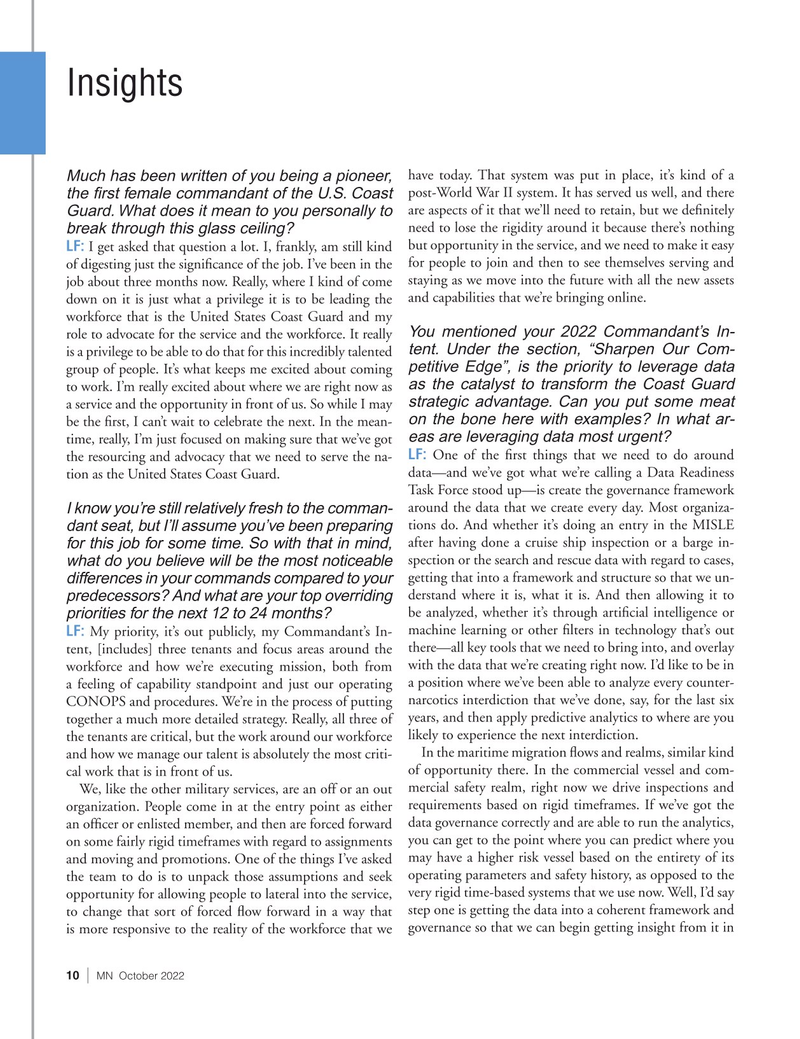
Page 10: of Marine News Magazine (October 2022)
MN100
Read this page in Pdf, Flash or Html5 edition of October 2022 Marine News Magazine
Insights have today. That system was put in place, it’s kind of a
Much has been written of you being a pioneer, post-World War II system. It has served us well, and there the ? rst female commandant of the U.S. Coast are aspects of it that we’ll need to retain, but we de? nitely
Guard. What does it mean to you personally to need to lose the rigidity around it because there’s nothing break through this glass ceiling?
LF: I get asked that question a lot. I, frankly, am still kind but opportunity in the service, and we need to make it easy of digesting just the signi? cance of the job. I’ve been in the for people to join and then to see themselves serving and job about three months now. Really, where I kind of come staying as we move into the future with all the new assets down on it is just what a privilege it is to be leading the and capabilities that we’re bringing online.
workforce that is the United States Coast Guard and my
You mentioned your 2022 Commandant’s In- role to advocate for the service and the workforce. It really tent. Under the section, “Sharpen Our Com- is a privilege to be able to do that for this incredibly talented petitive Edge”, is the priority to leverage data group of people. It’s what keeps me excited about coming as the catalyst to transform the Coast Guard to work. I’m really excited about where we are right now as strategic advantage. Can you put some meat a service and the opportunity in front of us. So while I may on the bone here with examples? In what ar- be the ? rst, I can’t wait to celebrate the next. In the mean- eas are leveraging data most urgent?
time, really, I’m just focused on making sure that we’ve got
LF: One of the ? rst things that we need to do around the resourcing and advocacy that we need to serve the na- data—and we’ve got what we’re calling a Data Readiness tion as the United States Coast Guard.
Task Force stood up—is create the governance framework around the data that we create every day. Most organiza-
I know you’re still relatively fresh to the comman- tions do. And whether it’s doing an entry in the MISLE dant seat, but I’ll assume you’ve been preparing after having done a cruise ship inspection or a barge in- for this job for some time. So with that in mind, spection or the search and rescue data with regard to cases, what do you believe will be the most noticeable getting that into a framework and structure so that we un- differences in your commands compared to your derstand where it is, what it is. And then allowing it to predecessors? And what are your top overriding be analyzed, whether it’s through arti? cial intelligence or priorities for the next 12 to 24 months?
machine learning or other ? lters in technology that’s out
LF: My priority, it’s out publicly, my Commandant’s In- tent, [includes] three tenants and focus areas around the there—all key tools that we need to bring into, and overlay workforce and how we’re executing mission, both from with the data that we’re creating right now. I’d like to be in a feeling of capability standpoint and just our operating a position where we’ve been able to analyze every counter-
CONOPS and procedures. We’re in the process of putting narcotics interdiction that we’ve done, say, for the last six together a much more detailed strategy. Really, all three of years, and then apply predictive analytics to where are you the tenants are critical, but the work around our workforce likely to experience the next interdiction.
In the maritime migration ? ows and realms, similar kind and how we manage our talent is absolutely the most criti- of opportunity there. In the commercial vessel and com- cal work that is in front of us.
We, like the other military services, are an off or an out mercial safety realm, right now we drive inspections and organization. People come in at the entry point as either requirements based on rigid timeframes. If we’ve got the an of? cer or enlisted member, and then are forced forward data governance correctly and are able to run the analytics, on some fairly rigid timeframes with regard to assignments you can get to the point where you can predict where you and moving and promotions. One of the things I’ve asked may have a higher risk vessel based on the entirety of its the team to do is to unpack those assumptions and seek operating parameters and safety history, as opposed to the opportunity for allowing people to lateral into the service, very rigid time-based systems that we use now. Well, I’d say to change that sort of forced ? ow forward in a way that step one is getting the data into a coherent framework and is more responsive to the reality of the workforce that we governance so that we can begin getting insight from it in 10 | MN October 2022

 9
9

 11
11
